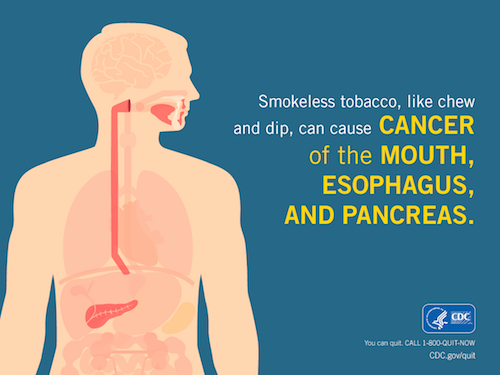Smokeless Tobacco: Health Effects
Smokeless tobacco is associated with many health problems. Using smokeless tobacco:
- Can lead to nicotine addiction1,2
- Causes cancer of the mouth, esophagus (the passage that connects the throat to the stomach), and pancreas (a gland that helps with digestion and maintaining proper blood sugar levels)1,2
- Is associated with diseases of the mouth1,3
- Can increase risks for early delivery and stillbirth when used during pregnancy2
- Can cause nicotine poisoning in children4
- May increase the risk for death from heart disease and stroke1,3
Using smokeless products can cause serious health problems. Protect your health; don't start. If you do use them, quit.
Addiction to Smokeless Tobacco
- Smokeless tobacco contains nicotine, which is highly addictive.1,2
- Because young people who use smokeless tobacco can become addicted to nicotine, they may be more likely to also become cigarette smokers.5
Smokeless Tobacco and Cancer
- Many smokeless tobacco products contain cancer-causing chemicals.1,6
- The most harmful chemicals are tobacco-specific nitrosamines, which form during the growing, curing, fermenting, and aging of tobacco. The amount of these chemicals varies by product.1
- The higher the levels of these chemicals, the greater the risk for cancer.2
- Other chemicals found in tobacco can also cause cancer. These include:6
- A radioactive element (polonium-210) found in tobacco fertilizer
- Chemicals formed when tobacco is cured with heat (polynuclear aromatic hydrocarbons—also known as polycyclic aromatic hydrocarbons)
- Harmful metals (arsenic, beryllium, cadmium, chromium, cobalt, lead, nickel, mercury)
- Smokeless tobacco causes cancer of the mouth, esophagus, and pancreas.1
Smokeless tobacco, like chew and dip, can cause cancer of the mouth, esophagus, and pancreas.
Larger infographic
Smokeless Tobacco and Oral Disease
- Smokeless tobacco can cause white or gray patches inside the mouth (leukoplakia) that can lead to cancer.1
- Smokeless tobacco can cause gum disease, tooth decay, and tooth loss.1,3
Reproductive and Developmental Risks
- Using smokeless tobacco during pregnancy can increase the risk for early delivery and stillbirth.2
- Nicotine in smokeless tobacco products that are used during pregnancy can affect how a baby’s brain develops before birth.2,7
Other Risks
- Using smokeless tobacco increases the risk for death from heart disease and stroke.1,3
- Smokeless tobacco can cause nicotine poisoning in children.4
- Additional research is needed to examine long-term effects of newer smokeless tobacco products, such as dissolvables and U.S. snus.
References
- World Health Organization. IARC Monographs on the Evaluation of Carcinogenic Risks to Humans. Volume 89: Smokeless Tobacco and Some Tobacco-Specific N-Nitrosamines.[PDF–3.18 MB] Lyon (France): World Health Organization, International Agency for Research on Cancer, 2007 [accessed 2014 Oct 31].
- U.S. Department of Health and Human Services.The Health Consequences of Smoking—50 Years of Progress: A Report of the Surgeon General. Atlanta: U.S. Department of Health and Human Services, Centers for Disease Control and Prevention, National Center for Chronic Disease Prevention and Health Promotion, Office on Smoking and Health, 2014 [accessed 2014 Oct 31].
- Piano MR, Benowitz NL, Fitzgerald GA, Corbridge S, Heath J, Hahn E, et al. Impact of Smokeless Tobacco Products on Cardiovascular Disease: Implications for Policy, Prevention, and Treatment: A Policy Statement from the American Heart Association. Circulation 2010;122(15):1520–44 [cited 2014 Oct 31].
- Connolly GN, Richter P, Aleguas A Jr, Pechacek TF, Stanfill SB, Alpert HR. Unintentional Child Poisonings Through Ingestion of Conventional and Novel Tobacco Products. Pediatrics 2010;125(5):896–9 [cited 2014 Oct 31].
- Lund I, Scheffels J. Smoking and Snus Use Onset: Exploring the Influence of Snus Debut Age on the Risk for Smoking Uptake With Cross-Sectional Survey Data. Nicotine and Tobacco Research 2014;16(6):815–9 [cited 2014 Oct 31].
- Stanfill SB, Connolly GN, Zhang L, Jia LT, Henningfield JE, Richter P, et al. Global Surveillance of Oral Tobacco Products: Total Nicotine, Unionised Nicotine and Tobacco-Specific N-Nitrosamines. Tobacco Control 2011 May;20(3):e2. doi:10.1136/tc.2010.037465 [cited 2014 Oct 31].
- California Environmental Protection Agency. Safe Drinking Water and Toxic Enforcement Act of 1986: Chemicals Known to the State to Cause Cancer or Reproductive Toxicity (May 2, 2014)..[PDF–403 KB] California Environmental Protection Agency, Office of Environmental Health Hazard Assessment [accessed 2014 Oct 31].
For Further Information
Centers for Disease Control and Prevention
National Center for Chronic Disease Prevention and Health Promotion
Office on Smoking and Health
E-mail: tobaccoinfo@cdc.gov
Phone: 1-800-CDC-INFO
Media Inquiries: Contact CDC's Office on Smoking and Health press line at 770-488-5493.
- Page last reviewed: December 1, 2016
- Page last updated: December 1, 2016
- Content source:


 ShareCompartir
ShareCompartir
